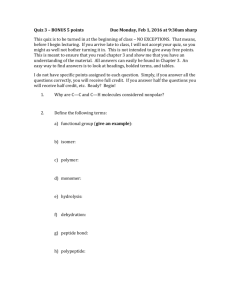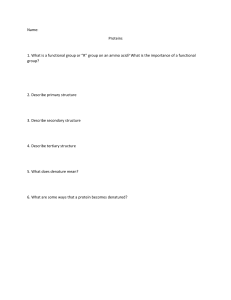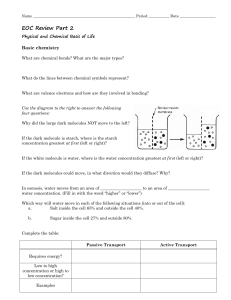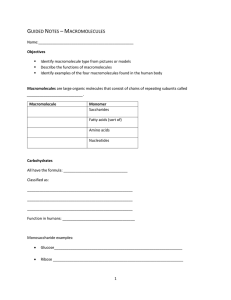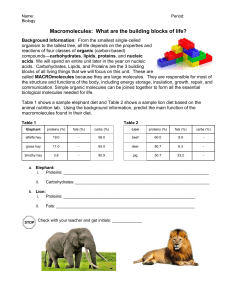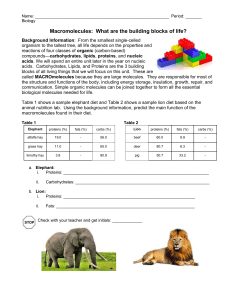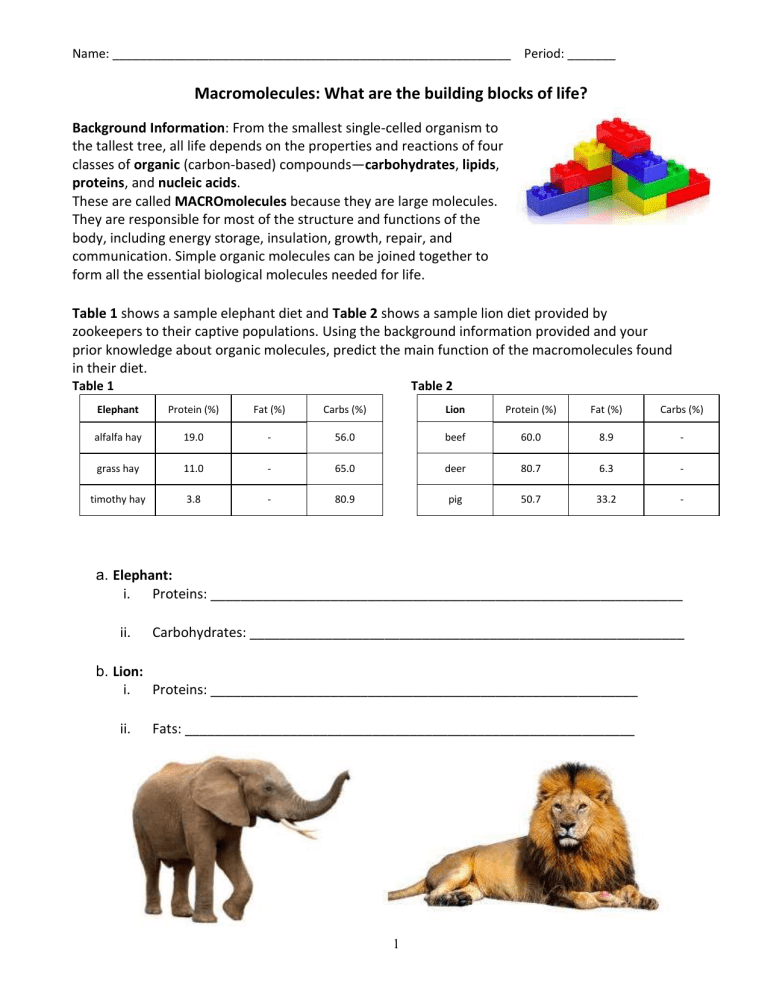
Name: __________________________________________________________ Period: _______ Macromolecules: What are the building blocks of life? Background Information: From the smallest single-celled organism to the tallest tree, all life depends on the properties and reactions of four classes of organic (carbon-based) compounds—carbohydrates, lipids, proteins, and nucleic acids. These are called MACROmolecules because they are large molecules. They are responsible for most of the structure and functions of the body, including energy storage, insulation, growth, repair, and communication. Simple organic molecules can be joined together to form all the essential biological molecules needed for life. Table 1 shows a sample elephant diet and Table 2 shows a sample lion diet provided by zookeepers to their captive populations. Using the background information provided and your prior knowledge about organic molecules, predict the main function of the macromolecules found in their diet. Table 1 Table 2 Elephant Protein (%) Fat (%) Carbs (%) Lion Protein (%) Fat (%) Carbs (%) alfalfa hay 19.0 - 56.0 beef 60.0 8.9 - grass hay 11.0 - 65.0 deer 80.7 6.3 - timothy hay 3.8 - 80.9 pig 50.7 33.2 - a. Elephant: i. Proteins: _______________________________________________________________ ii. Carbohydrates: __________________________________________________________ b. Lion: i. Proteins: _________________________________________________________ ii. Fats: ____________________________________________________________ 1 Directions: Analyze Model 1 and answer the questions that follow. Questions: 1. Carbohydrate is a macromolecule. This means that it is a large or small molecule. (circle one) 2. Use Model 1 to show which atoms are present in each type of molecule by listing the symbol for each atom included (an atom = element in the molecule). Carbohydrate has been done for you. a. Carbohydrate: C, H, O b. Lipid: ______________________ c. Protein: ________________________ 3. List 3 similarities between the 3 types of macromolecules. a. _________________________________________________________ b. _________________________________________________________ c. _________________________________________________________ 4. List 3 differences between the 3 types of macromolecules. a. _________________________________________________________ b. _________________________________________________________ c. _________________________________________________________ 2 Read This! During chemical reactions, the bonds in molecules are continually broken and reformed. When bonds are broken, energy is released. When bonds are formed, energy is absorbed. If more energy is released than absorbed during a chemical change, the process can be used as a source of energy. A general rule for processes such as respiration is the more carbon atoms there are in a molecule, the more energy that molecule can provide to the organism when it is used as food. 5. Using the information from above and Model 1, is a carbohydrate, lipid, or a protein more likely to be a good source of energy for an organism? Use comparative data to support your answer. ____________________________________________________________________________________ Background Information: There are many chemical reactions occurring in your body right now. As you eat food, these food molecules are broken down by enzymes and a chemical reaction takes place. The bonds between elements are broken and reformed – energy can be given off or taken in when the reaction occurs. The left side (before arrow) of the reaction (what goes in) is called the reactants while the right side (after arrow) of the reaction (what comes out) is called the products. The number of elements that go into the reaction should be the same number of elements that come out of the reaction. Analyze the two models showing the elephant’s diet and lion’s diet and answer the questions that follow. MODEL 2: Elephant’s Diet - Carbohydrates 6. The reactants are ________________________ and _____________________________. 7. The products are _________________________ and ____________________________. 8. Would you say that glucose or sucrose is more complex? (circle one) Why? ___________________________________________________________________________________ ___________________________________________________________________________________ 9. What would you call the process that is occurring? ___________________________ 10. What is the elephant getting when the bond is broken in sucrose? _______________________ 11. Starch is a complex carbohydrate found in plants which contains approximately 200 glucose molecules. Predict the function of starch and explain why. 3 Function: ___________________________________________ Explain Why: _______________________________________________________________________ 4 MODEL 3: Elephant’s Diet and Lion’s Diet - Proteins 12. What would you call the process that is occurring? _________________________________ Read This! There are only 20 different amino acids found in the body, however, there are thousands of different proteins being used by your cells. Proteins differ in their types and sequence of the number of amino acids which allows for the thousands of different proteins found in your body. When you consume protein, it is broken down into individual amino acids. These amino acids are then used to make new proteins. Amino acid 1 Amino acid 2 Amino acid 3 13. Based on the information above about how proteins are made and are different, use the 3 amino acids above to create 2 proteins with 4 amino acids. a. Protein 1: ___________________________________________________________________________ b. Protein 2: ___________________________________________________________________________ 5 MODEL 4: Lion’s Diet - Lipids 14. The reactants are __________________________ and ___________________________ 15. The products are ___________________________ and ___________________________ 16. Think about the relationship between carbon atoms and energy, then finish this sentence: Because a monoglyceride molecule has more carbon atoms than a glucose molecule, you can assume that … ________________________________________________________________________________ ________________________________________________________________________________ 6 Name: __________________________________________________________ Period: _______ Claim: Elephants and lions need energy to survive. Evidence: Use Tables 1 and 2 (on page 1 of “Macromolecules: What are the building blocks of life”) to provide data. Elephants use ___________________________ as their main energy source. ________________________________________________________________________________ ________________________________________________________________________________ ________________________________________________________________________________ ________________________________________________________________________________ Lions use ___________________________ as their main energy source. ________________________________________________________________________________ ________________________________________________________________________________ ________________________________________________________________________________ ________________________________________________________________________________ Reasoning: Use the Read This! (on page 2 of “Macromolecules: What are the building blocks of life”) and Models 2, 3, and 4 to support your reasoning. Elephants ________________________________________________________________________________ ________________________________________________________________________________ ________________________________________________________________________________ ________________________________________________________________________________ Lions ________________________________________________________________________________ ________________________________________________________________________________ ________________________________________________________________________________ ________________________________________________________________________________ 7

